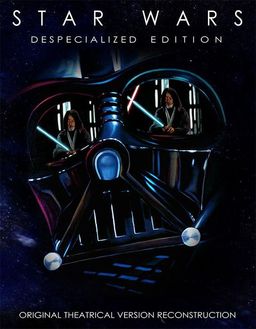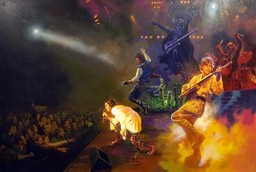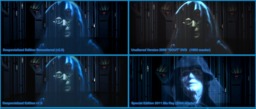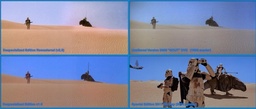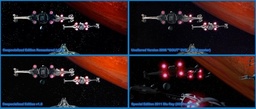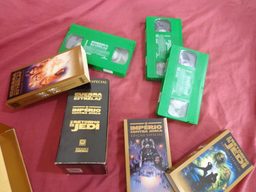Bruce Torres
Let's be alone together.
You can watch an 'unaltered' version of Star Wars in HD today, if you bend the law
By Ben Kuchera on Aug 18, 2014 at 1:00p
Star Wars is close to holy for many fans of cinema.
We remember growing up with the movies, and having them look a very specific way. You think of the colors of certain scenes, and the fact that Han shot first. The X-Wings fly in very distinct patterns.
The Star Wars that was released in 1977 no longer exists. The film has been edited, special effects shots have been swapped, colors have been changed and more. Lucas has worried over the films so much that those of us who wish for the version of the film we remember have no way to watch the movie that means so much to us. Instead, we're treated to a series of re-releases from mediocre sources, with massive flaws in the presentation.
This is why rumors of a remastered, unaltered original trilogy are so thrilling. It would mean that fans of the series have a way to watch the film as they remember, on modern equipment, with time and money spent remastering and correcting decades worth of film degradation and wear.
Lucas has long said this was impossible but, as I explored in an earlier story at Ars Technica, that’s untrue.
Besides, the holy grail exists today. It’s called the Despecialized Edition, and the only problem is that you can’t pay money for it. This is an a gray-market release of the film, only available as a huge download on bittorrent. So what do you get for your 17GB of hard drive space?
You get everything you want. You get a long time ago, far far away in the most stunning presentation possible.
HARMY
The Despecialized Edition is the years-long work of a diverse group of people who have taken elements from many different sources and created the ultimate version of the first Star Wars film. It has also been upgraded to display properly on high definition screens, with high-quality sounds and a near perfect image.
The latest Blu-Ray release of the film serves as the skeleton for this edition, but elements of the 2006 bonus DVD that included the unaltered version of the film was also used to remove special effects and edits that were added by Lucas.
Even these basic, official sources weren’t perfect, though. For such a fan of technology, Lucas and his crew have long presented us with mediocre versions of the source material.
"An overall color correction was first performed by an OriginalTrilogy.com member called You_Too, who wrote an AVISynth script to fix some of the worst color issues of the 2004 master," the documentary about the sources stated. "Mainly the ever present magenta tones, which are especially visible in laser fire flash frames, but in other instances as well. At the end, a shot by shot color correction was done based on the colors of a well preserved Technicolor print."
Wait a minute, there are working prints of the film in existence? Yep, although they’re rarely shown to the public.
"One print is special. It is a Technicolor imbibition dye-transfer print. This means: it has a finer grain and better picture, but, more importantly, it looks exactly the same as the day it was printed. Properly cared for, it will outlast all of us," an article about one such viewing on Saving Star Wars explained.
Remember though, there is no one perfect source, which is why this project was so ambitious. "It doesn't look anything like the 1993 Laserdisc or the 2006 DVD, with all of its dirt and grain, and the colors are terrific," the article said. "The Star Destroyer fly-by looked pretty pink, as it is from a 1981 photochemical splice-in for the re-release that year."
Other prints of the original film have been shown, but it’s reported that they’re confiscated by Lucasfilm when they surface. Still, the print described in that article is an amazing piece of history, as shown by this image taken from the theater's screen.
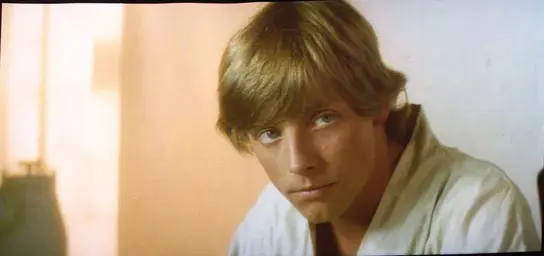
These primary sources give us a good idea of how the film is supposed to look, the original version shown in theaters in the later 70s. It's just a matter of tracking them down and making sure they're presented in the best possible way.
Puggo Grande is another legendary object for fans of the original film, and it served as a source for content for scenes that needed to be restored to remove edits or special effects that weren’t in the original version of the film
"[Puggo Grande] is my telecine transfer and restoration of an old 16mm print of Star Wars. The film was borrowed from a source who wishes to remain anonymous, and who for now will go by the name Jaxxon," the official site for the content says.
"Actually, Jaxxon provided me with two prints, both of which have the original crawl. One of the prints has Swedish subtitles and the mono mix. I used the Swedish version as a source for the mono mix and for a few video segments when needed to patch damaged frames. The Swedish print was later restored separately.

You can see the quality of the transfer in the included image, and it’s not great. But for reference material and to grab elements that can be edited together to recreate certain scenes it’s invaluable.
Other still images, reference material, and even other partial prints were used, upscaled, color-corrected, and edited together to create the final version of the Despecialized Edition.
These sources have been chopped up, enhanced, color-corrected, edited together, cleaned, and ultimately released as one huge 17.8GB MKV file in all the places one would expect to find gray market, if not outright pirated, films. So how is it?
THE EXPERIENCE
The release is now up to version 2.5, and it's literally one of the most jaw-dropping presentations of classic science fiction I have ever seen. The colors look amazing, details pop off the screen and the overall image quality is so far beyond anything available in an officially sanctioned release that it's nearly laughable.
I've been lucky enough to see the Despecialized Edition in a few barely advertised public screenings and in the home theater of friends, and it's startling to see the film you know versus the poorly updated and re-edited versions we're used to from Lucas.
Even the audio options are top notch. "Version v2.5 offers few more little tweaks to the picture and contains an unprecedented number of audio options, including lossless DTS-HD tracks for the original mixes, an isolated score, four different commentary tracks and dubbing tracks in ten different languages and dialects," the official release notes state.
It is, to put it in very simple terms, Star Wars. It's the version we've always wanted, with an immense amount of effort put into retaining the original vision of the film. You can't buy it, it won't be shown at your local cinema, and the legality of the project is questionable at best, but the version of Star Wars you've always dreamed of is available online.
Fonte: http://www.polygon.com/2014/8/18/6030725/star-wars-hd-despecialized-edition
------------------------------------------------------------------------------------------------------------------------------
Meu comentário: recentemente fiz a Laila assistir a trilogia original. Entretanto, ao invés de exibir a última edição lançada dos filmes - aquela cheia de alterações consideradas controversas, como Yoda animado, Christensen no lugar de Shaw como Vader no fim de Retorno, etc. -, baixei um arquivo em torrent (que não irei disponibilizar aqui por motivos óbvios) que continha as edições lançadas antes mesmo das alterações (mais uma vez) desnecessárias de Lucas em 1997, como a cena do Han Solo pisando em Jabba em Esperança, extraídas da cópia em laserdisc de 1993. Considerando que nosso "amado" criador de Star Wars agora não detém mais os direitos da franquia (yes, yes, yes), podemos esperar que um dia a cópia de 1993 seja relançada - na minha opinião é a melhor edição disponível, com a mudança do título de apenas Star Wars para Star Wars: A New Hope. Enquanto isso, a edição mencionada no artigo parece ser um item a ser considerado. Mas fica claro que o comentarista aqui não está apoiando a pirataria e que o artigo trata também das comparações entre as edições disponíveis. O que vocês fizerem com isso é problema de vocês.
***************************************************************************************
UltraFlix hires 'Star Wars: Despecialized Edition' editor to help oversee 4K conversions
Mark Hachman | @markhachman
Senior Editor, TechHive
NanoTech Entertainment said Monday that it had hired Petr Harmy, who created the Star Wars Despecialized Edition remastered trilogy, to help it convert existing movies into 4K resolution for its UltraFlix 4K streaming service.
Harmy confirmed the move on the OriginalTrilogy website, which was first formed to petition Star Wars creator George Lucas to release a high-definition version of the original Star Wars trilogy.
Instead, Harmy, working from prints of the original celluloid film, Blu-ray releases, and other sources, created the Despecialized Edition, a 720p version of the original Star Wars trilogy with the original effects intact. The current version 2.5 copy includes yet another remaster, as Harmy went through each frame and made adjustments. (It's also, technically, a bootleg copy of the film, which can be found on sites that specialize in such content.)
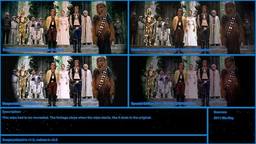
PETR HARMY
On Facebook, Harmy posted example frames from the different versions of the Star Wars film.
Now, Harmy will be taking his talents to NanoTech, which is busy trying to create a library of 4K films for sale and eventually rental as part of its UltraFlix service. UltraFlix hopes to create a competitor to Amazon, Netflix, and others by specializing in streaming 4K movies.
"I’ve always been a big proponent of presenting movies in the best possible quality while maintaining their original artistic integrity,” Harmy said in a statement. “I am very excited to be joining the 4K Studios as part of the UltraFlix team.”
At the Consumer Electronics Show this past January, Ultraflix executives said that the company had recently formed a 4K post-production transfer studio and would convert movies from studio vaults in exchange for a period of exclusivity, on the order of three months. That studio is apparently being called 4K Studios, and will employ Harmy.
According to UltraFlix executives, celluloid film contains enough information to reconstruct an 8K copy. Harmy will be asked to help restore, reconstruct, and enhance these older films into something that looks fresh and clean for the digital age.
On UltraFlix, movies are clearly labeled “Silver,” “Gold,” and “Platinum,” with upconverted 1080p movies assigned a Silver rating, older film transfers labeled as Gold movies, and native 4K movies given a Platinum designation. Although NanoTech receives its 4K content from the studios themselves, the “Remastered by 4K Studios" effort that Harmy will be a part of will apparently give the films that Ultraflix receives something like the Despecialized treatment, cleaning them up and improving the quality. The "Remastered by 4K Studios" logo will actually appear as part of the film itself as branding, NanoTech said.
Why this matters: At this point, NanoTech isn't really a known entity, and neither is its UltraFlix service. Hiring a bit of name recognition as part of its staffing efforts certainly can't hurt. Frankly, we're hard pressed to believe that any service could lavish the sort of attention that Harmy supplied to the Star Wars trilogy to the emerging wave of 4K content, but we wish them all the best in doing so.
Fonte: http://www.techhive.com/article/288...on-editor-to-help-oversee-4k-conversions.html
By Ben Kuchera on Aug 18, 2014 at 1:00p
Star Wars is close to holy for many fans of cinema.
We remember growing up with the movies, and having them look a very specific way. You think of the colors of certain scenes, and the fact that Han shot first. The X-Wings fly in very distinct patterns.
The Star Wars that was released in 1977 no longer exists. The film has been edited, special effects shots have been swapped, colors have been changed and more. Lucas has worried over the films so much that those of us who wish for the version of the film we remember have no way to watch the movie that means so much to us. Instead, we're treated to a series of re-releases from mediocre sources, with massive flaws in the presentation.
This is why rumors of a remastered, unaltered original trilogy are so thrilling. It would mean that fans of the series have a way to watch the film as they remember, on modern equipment, with time and money spent remastering and correcting decades worth of film degradation and wear.
Lucas has long said this was impossible but, as I explored in an earlier story at Ars Technica, that’s untrue.
Besides, the holy grail exists today. It’s called the Despecialized Edition, and the only problem is that you can’t pay money for it. This is an a gray-market release of the film, only available as a huge download on bittorrent. So what do you get for your 17GB of hard drive space?
You get everything you want. You get a long time ago, far far away in the most stunning presentation possible.
HARMY
The Despecialized Edition is the years-long work of a diverse group of people who have taken elements from many different sources and created the ultimate version of the first Star Wars film. It has also been upgraded to display properly on high definition screens, with high-quality sounds and a near perfect image.
The latest Blu-Ray release of the film serves as the skeleton for this edition, but elements of the 2006 bonus DVD that included the unaltered version of the film was also used to remove special effects and edits that were added by Lucas.
Even these basic, official sources weren’t perfect, though. For such a fan of technology, Lucas and his crew have long presented us with mediocre versions of the source material.
"An overall color correction was first performed by an OriginalTrilogy.com member called You_Too, who wrote an AVISynth script to fix some of the worst color issues of the 2004 master," the documentary about the sources stated. "Mainly the ever present magenta tones, which are especially visible in laser fire flash frames, but in other instances as well. At the end, a shot by shot color correction was done based on the colors of a well preserved Technicolor print."
Wait a minute, there are working prints of the film in existence? Yep, although they’re rarely shown to the public.
"One print is special. It is a Technicolor imbibition dye-transfer print. This means: it has a finer grain and better picture, but, more importantly, it looks exactly the same as the day it was printed. Properly cared for, it will outlast all of us," an article about one such viewing on Saving Star Wars explained.
Remember though, there is no one perfect source, which is why this project was so ambitious. "It doesn't look anything like the 1993 Laserdisc or the 2006 DVD, with all of its dirt and grain, and the colors are terrific," the article said. "The Star Destroyer fly-by looked pretty pink, as it is from a 1981 photochemical splice-in for the re-release that year."
Other prints of the original film have been shown, but it’s reported that they’re confiscated by Lucasfilm when they surface. Still, the print described in that article is an amazing piece of history, as shown by this image taken from the theater's screen.

These primary sources give us a good idea of how the film is supposed to look, the original version shown in theaters in the later 70s. It's just a matter of tracking them down and making sure they're presented in the best possible way.
Puggo Grande is another legendary object for fans of the original film, and it served as a source for content for scenes that needed to be restored to remove edits or special effects that weren’t in the original version of the film
"[Puggo Grande] is my telecine transfer and restoration of an old 16mm print of Star Wars. The film was borrowed from a source who wishes to remain anonymous, and who for now will go by the name Jaxxon," the official site for the content says.
"Actually, Jaxxon provided me with two prints, both of which have the original crawl. One of the prints has Swedish subtitles and the mono mix. I used the Swedish version as a source for the mono mix and for a few video segments when needed to patch damaged frames. The Swedish print was later restored separately.

You can see the quality of the transfer in the included image, and it’s not great. But for reference material and to grab elements that can be edited together to recreate certain scenes it’s invaluable.
Other still images, reference material, and even other partial prints were used, upscaled, color-corrected, and edited together to create the final version of the Despecialized Edition.
These sources have been chopped up, enhanced, color-corrected, edited together, cleaned, and ultimately released as one huge 17.8GB MKV file in all the places one would expect to find gray market, if not outright pirated, films. So how is it?
THE EXPERIENCE
The release is now up to version 2.5, and it's literally one of the most jaw-dropping presentations of classic science fiction I have ever seen. The colors look amazing, details pop off the screen and the overall image quality is so far beyond anything available in an officially sanctioned release that it's nearly laughable.
I've been lucky enough to see the Despecialized Edition in a few barely advertised public screenings and in the home theater of friends, and it's startling to see the film you know versus the poorly updated and re-edited versions we're used to from Lucas.
Even the audio options are top notch. "Version v2.5 offers few more little tweaks to the picture and contains an unprecedented number of audio options, including lossless DTS-HD tracks for the original mixes, an isolated score, four different commentary tracks and dubbing tracks in ten different languages and dialects," the official release notes state.
It is, to put it in very simple terms, Star Wars. It's the version we've always wanted, with an immense amount of effort put into retaining the original vision of the film. You can't buy it, it won't be shown at your local cinema, and the legality of the project is questionable at best, but the version of Star Wars you've always dreamed of is available online.
Fonte: http://www.polygon.com/2014/8/18/6030725/star-wars-hd-despecialized-edition
------------------------------------------------------------------------------------------------------------------------------
Meu comentário: recentemente fiz a Laila assistir a trilogia original. Entretanto, ao invés de exibir a última edição lançada dos filmes - aquela cheia de alterações consideradas controversas, como Yoda animado, Christensen no lugar de Shaw como Vader no fim de Retorno, etc. -, baixei um arquivo em torrent (que não irei disponibilizar aqui por motivos óbvios) que continha as edições lançadas antes mesmo das alterações (mais uma vez) desnecessárias de Lucas em 1997, como a cena do Han Solo pisando em Jabba em Esperança, extraídas da cópia em laserdisc de 1993. Considerando que nosso "amado" criador de Star Wars agora não detém mais os direitos da franquia (yes, yes, yes), podemos esperar que um dia a cópia de 1993 seja relançada - na minha opinião é a melhor edição disponível, com a mudança do título de apenas Star Wars para Star Wars: A New Hope. Enquanto isso, a edição mencionada no artigo parece ser um item a ser considerado. Mas fica claro que o comentarista aqui não está apoiando a pirataria e que o artigo trata também das comparações entre as edições disponíveis. O que vocês fizerem com isso é problema de vocês.
***************************************************************************************
UltraFlix hires 'Star Wars: Despecialized Edition' editor to help oversee 4K conversions
Mark Hachman | @markhachman
Senior Editor, TechHive
NanoTech Entertainment said Monday that it had hired Petr Harmy, who created the Star Wars Despecialized Edition remastered trilogy, to help it convert existing movies into 4K resolution for its UltraFlix 4K streaming service.
Harmy confirmed the move on the OriginalTrilogy website, which was first formed to petition Star Wars creator George Lucas to release a high-definition version of the original Star Wars trilogy.
Instead, Harmy, working from prints of the original celluloid film, Blu-ray releases, and other sources, created the Despecialized Edition, a 720p version of the original Star Wars trilogy with the original effects intact. The current version 2.5 copy includes yet another remaster, as Harmy went through each frame and made adjustments. (It's also, technically, a bootleg copy of the film, which can be found on sites that specialize in such content.)

PETR HARMY
On Facebook, Harmy posted example frames from the different versions of the Star Wars film.
Now, Harmy will be taking his talents to NanoTech, which is busy trying to create a library of 4K films for sale and eventually rental as part of its UltraFlix service. UltraFlix hopes to create a competitor to Amazon, Netflix, and others by specializing in streaming 4K movies.
"I’ve always been a big proponent of presenting movies in the best possible quality while maintaining their original artistic integrity,” Harmy said in a statement. “I am very excited to be joining the 4K Studios as part of the UltraFlix team.”
At the Consumer Electronics Show this past January, Ultraflix executives said that the company had recently formed a 4K post-production transfer studio and would convert movies from studio vaults in exchange for a period of exclusivity, on the order of three months. That studio is apparently being called 4K Studios, and will employ Harmy.
According to UltraFlix executives, celluloid film contains enough information to reconstruct an 8K copy. Harmy will be asked to help restore, reconstruct, and enhance these older films into something that looks fresh and clean for the digital age.
On UltraFlix, movies are clearly labeled “Silver,” “Gold,” and “Platinum,” with upconverted 1080p movies assigned a Silver rating, older film transfers labeled as Gold movies, and native 4K movies given a Platinum designation. Although NanoTech receives its 4K content from the studios themselves, the “Remastered by 4K Studios" effort that Harmy will be a part of will apparently give the films that Ultraflix receives something like the Despecialized treatment, cleaning them up and improving the quality. The "Remastered by 4K Studios" logo will actually appear as part of the film itself as branding, NanoTech said.
Why this matters: At this point, NanoTech isn't really a known entity, and neither is its UltraFlix service. Hiring a bit of name recognition as part of its staffing efforts certainly can't hurt. Frankly, we're hard pressed to believe that any service could lavish the sort of attention that Harmy supplied to the Star Wars trilogy to the emerging wave of 4K content, but we wish them all the best in doing so.
Fonte: http://www.techhive.com/article/288...on-editor-to-help-oversee-4k-conversions.html

